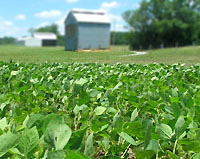Waiting And Watching For Soybean Rust
Waiting And Watching For Soybean Rust

The sentinels are in place, ready to sound the alarm should Kentucky’s soybean fields come under fire from a new, potentially devastating disease.
Asian soybean rust was discovered for the first time in the United States this past fall in nine southern states. Since that discovery, and even before, plant disease specialists have been educating producers, field scouts, agricultural suppliers and others about this new threat.
To date, the disease has not been detected anywhere in Kentucky, and where it has been found this spring (Georgia and Florida), it is not moving as quickly as anticipated, said Don Hershman, plant pathologist with the University of Kentucky Cooperative Extension Service.
“It’s moving very slow, and even in Florida it’s only been found on kudzu,” he said. “They have sentinel plots but so far, they are just not seeing it move to other nearby crops. In southwest Georgia , they’ve found it on volunteer soybeans but it’s not spreading.
“Clearly there are very specific conditions, and when they are met, this disease will explode. We apparently haven’t seen those conditions and we don’t understand quite a bit about the disease,” Hershman said. “We are all perplexed. It’s not moving as quickly as we thought it would. But that’s a good thing, because the later it comes into the state, the less damage potential there will be. Our crop is very young yet and will be through the month of July, so there’s still a lot of potential for it to explode.”
Hershman said the impact of tropical storm Arlene on possible disease spread won’t be known until late June. The storm made its way across parts of Florida , Louisiana , most of Georgia , Alabama , Mississippi and Tennessee and into parts of western Kentucky .
U.S. Department of Agriculture models that track spore movement indicate the spores may have moved into these states. However, the lack of knowledge of spore source areas and levels makes it impossible to assess the true threat of the disease at this time, Hershman said.
“Right now, and until we have some indication that soybean rust has moved out of its current locations of central Florida and southwest Georgia, the prudent thing to do at this time is wait, watch and listen,” he said.
To help Hershman and others watch for the disease, sentinel plots have been planted across the state. These plots were planted earlier than usual and with an early maturing variety to get the plants to canopy as quickly as possible. This encourages soybean rust development if the spores are in the area, aiding in earlier detection. The plots are part of the National Soybean Rust Sentinel and Monitoring Network, a U.S. Department of Agriculture’s Animal and Plant Health Inspection Service project.
Thirty-six soybean sentinel plots have been planted in Kentucky and are scouted weekly. In addition, 13 locations with kudzu are also being monitored. Kudzu grows along many highways and can act as host for the disease. Scouting will increase to twice a week when the potential for the disease is high.
Hershman encourages producers to stay up-to-date on rust activity, and that can be accomplished by going to the U.S. Department of Agriculture’s soybean rust Web site, http://www.sbrusa.net. The site gives up-to-date information about rust movement as well as comments from plant disease specialists for each state. Hershman’s comments, which he updates on a regular basis, can be found on the site. County Extensionoffices also have a good supply of information on soybean rust.
